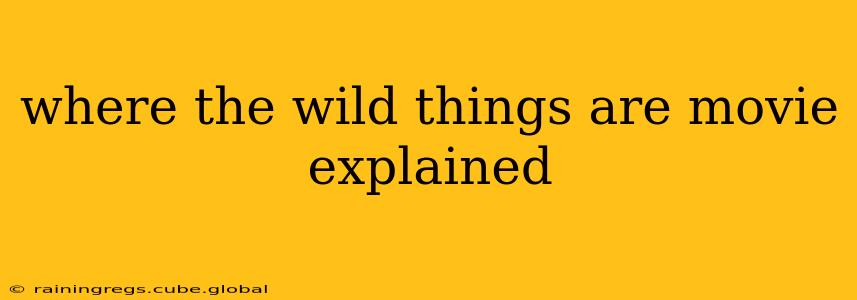Spike Jonze's 2009 adaptation of Maurice Sendak's beloved children's book, Where the Wild Things Are, isn't just a whimsical adventure; it's a poignant exploration of childhood anger, loneliness, and the complex process of growing up. While the film retains the core imagery of the book, it delves much deeper into the emotional landscape of Max, the story's protagonist, offering a nuanced and sometimes unsettling portrayal of childhood turmoil. This explanation will unpack the movie's themes, symbolism, and lasting impact.
What is the Movie About?
The film follows Max, a young boy struggling with intense emotions. After a furious outburst at home, he sails away on a makeshift boat to an island inhabited by wild things – large, furry creatures who are both frightening and strangely familiar. He becomes their king, engaging in boisterous play and revelry, but beneath the surface of the fun lies a deeper exploration of Max's emotional turmoil. His interactions with the wild things mirror his own internal conflicts, ultimately leading him to confront his loneliness and find a path back home.
What are the Wild Things?
What do the wild things represent? This is a central question many viewers grapple with. The wild things aren't simply monsters; they're manifestations of Max's own untamed emotions and the complex feelings he's suppressing. Each wild thing embodies a different aspect of his inner world, representing anger, sadness, frustration, and the desire for connection. Their chaotic behavior reflects Max's own emotional instability.
Is the Island Real or Imaginary?
Is the island a fantasy? The film deliberately blurs the line between reality and imagination. The island, and the wild things themselves, are likely a product of Max's imagination, a manifestation of his inner world and his coping mechanisms. However, the film's power lies in its refusal to explicitly label it as one or the other. The experience feels profoundly real to Max, showcasing the powerful impact of a child's imagination and its role in processing difficult emotions.
Why Does Max Return Home?
Why does Max go back home? Max's eventual return isn't simply a matter of tiring of the wild things' antics; it's a culmination of his emotional journey. He begins to realize that while the wild things provide a temporary outlet for his anger and loneliness, they can't ultimately fill the void he feels. He misses his mother's love and the comfort of home, signifying a growing understanding of his emotional needs and the importance of healthy relationships. The film subtly suggests that genuine connection, not escapism, is the key to emotional well-being.
What is the Meaning of the Ending?
What is the significance of the final scene? The final scene, where Max finds his dinner waiting for him, is beautifully ambiguous. It's a potent image of unconditional love and acceptance. The food, still warm, symbolizes his mother's enduring love and her unwavering patience, even amidst his outbursts. This ending leaves room for the audience to reflect on their own relationships and the power of forgiveness and understanding.
The Lasting Impact of Where the Wild Things Are
Spike Jonze's Where the Wild Things Are is a cinematic masterpiece because it transcends its initial premise of a children's story. It tackles complex emotions with sensitivity and honesty, making it resonate with viewers of all ages. Its exploration of childhood angst, the power of imagination, and the importance of human connection continues to inspire discussions and analysis years after its release. The film's enduring appeal lies in its willingness to confront the less-pleasant aspects of childhood and to present them with both compassion and artistic brilliance.
